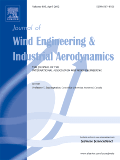
JOURNAL OF WIND ENGINEERING AND INDUSTRIAL AERODYNAMICS
Scope & Guideline
Pioneering Research on Wind Effects in Engineering
Introduction
Aims and Scopes
- Wind Load Analysis and Structural Response:
Research on wind loads acting on various structures, including buildings, bridges, and wind turbines, focusing on their dynamic response and stability under wind-induced forces. - Aerodynamics of Vehicles and Structures:
Studies involving the aerodynamic performance of vehicles, including trains and cars, as well as tall buildings and other structures, analyzing their design and operational efficiency in wind environments. - Numerical and Experimental Methods:
Utilization of computational fluid dynamics (CFD), large-eddy simulations (LES), and wind tunnel experiments to predict and analyze wind behavior and its effects on structures. - Renewable Energy Applications:
Exploration of wind energy technologies, including wind turbine aerodynamics and energy efficiency, along with related environmental impacts and optimization strategies. - Environmental Wind Effects:
Investigations into the impacts of wind on environmental phenomena, including pollutant dispersion, microclimates, and the effects of urban design on wind flow. - Innovative Control Strategies:
Development of novel strategies and technologies for controlling wind-induced vibrations and enhancing the stability of structures through passive and active methods.
Trending and Emerging
- Machine Learning and AI Applications:
An increasing number of studies are utilizing machine learning and artificial intelligence to enhance predictions of wind loads, structural responses, and energy efficiency in wind-related applications. - Advanced Numerical Simulation Techniques:
There is a growing trend toward the use of advanced numerical methods, such as large-eddy simulations (LES) and hybrid approaches, to more accurately model complex wind interactions with structures. - Resilience and Adaptation Strategies:
Research focusing on the resilience of structures against extreme wind events, including the impact of climate change on wind patterns and the development of adaptation strategies for infrastructure. - Urban Wind Dynamics:
A significant increase in studies on urban wind dynamics, particularly how urban design influences wind flow and its implications for pedestrian comfort and safety. - Innovative Wind Energy Solutions:
Emerging research on novel wind energy technologies, including optimization of turbine designs and integration of renewable energy systems into urban environments. - Health and Safety Assessments:
An uptick in studies assessing the health impacts of wind on urban populations, including pollutant dispersion and thermal comfort, as well as safety evaluations for structures under extreme wind conditions.
Declining or Waning
- Traditional Wind Engineering Approaches:
Older methodologies such as simple static wind load calculations are becoming less common as researchers increasingly adopt sophisticated numerical simulations and experimental techniques. - Basic Wind Speed Measurements:
The focus on basic observational studies of wind speed is waning, as more emphasis is placed on complex modeling and predictive analytics for dynamic wind conditions. - Single-Disciplinary Studies:
Research papers focused solely on theoretical aspects without practical applications or interdisciplinary approaches are becoming less frequent, reflecting a trend towards integrated studies that combine various engineering disciplines. - Simplistic Energy Models:
Basic models for predicting wind energy potential are declining in favor of more comprehensive approaches that account for complex local conditions and advanced forecasting techniques.
Similar Journals

Atmospheric Environment-X
Unlocking the secrets of our atmosphere for a better tomorrow.Atmospheric Environment-X, published by Elsevier Science Ltd, is a premier, open-access journal dedicated to advancing our understanding of atmospheric science and environmental disciplines. Since its inception in 2019, the journal has established itself as a critical platform for disseminating high-quality research, evident by its impressive Scopus rankings—39th out of 233 in General Environmental Science and 27th out of 148 in Atmospheric Science, placing it within the top quartiles of its fields. Operating from the United Kingdom, Atmospheric Environment-X aims to bridge the gap between fundamental research and practical applications, addressing pressing issues related to air quality, climate change, and environmental sustainability. With its commitment to open access, the journal encourages broad accessibility of knowledge, ensuring that cutting-edge research reaches a global audience of researchers, professionals, and students eager to contribute to the field. Join us as we explore the complexities of our atmosphere and its critical interactions with the environment through groundbreaking studies published up to 2024.
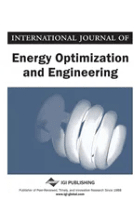
International Journal of Energy Optimization and Engineering
Exploring Strategies for a Greener FutureThe International Journal of Energy Optimization and Engineering, published by IGI Global, is a leading platform dedicated to advancing the field of energy management and optimization. With its ISSN 2160-9500 and E-ISSN 2160-9543, this journal serves as an essential resource for researchers, professionals, and students interested in innovative strategies for energy efficiency and sustainability. Although it does not currently offer Open Access options, the journal is committed to high-quality peer-reviewed content that aims to address the pressing challenges of energy consumption, renewable resources, and optimization techniques in engineering applications. The significance of this journal in the evolving landscape of energy technologies makes it an invaluable source for those aspiring to contribute to the development of sustainable energy practices across the globe.
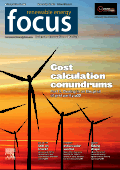
Renewable Energy Focus
Leading the Way in Sustainable Energy InnovationsRenewable Energy Focus is a premier journal published by Elsevier, dedicated to advancing the field of renewable energy and sustainability. With an ISSN of 1755-0084 and an E-ISSN of 1878-0229, this journal serves as a vital platform for researchers, professionals, and students interested in innovative solutions to energy challenges. Established in 2007, the journal has evolved to become a recognized authority in the subject area, currently ranked in the Q2 quartile of its category for 2023, emphasizing its significance in promoting impactful research. The journal encompasses a wide range of topics, including solar, wind, bioenergy, and sustainable practices that contribute to environmental conservation and energy efficiency. As part of Elsevier's commitment to disseminating high-quality research, Renewable Energy Focus is indexed in Scopus, currently holding a rank of #92/270 in the energy sector, positioning it in the 66th percentile of its field. This journal offers an essential resource for those dedicated to fostering sustainable energy solutions.

Joule
Bridging Research and Application in Energy SolutionsJoule, published by CELL PRESS, is a premier journal dedicated to the rapidly evolving field of energy research. Since its inception in 2017, Joule has established itself as a leading source of high-impact studies in energy, achieving an outstanding Q1 ranking in the Energy (miscellaneous) category and ranking #1 out of 73 in the general energy field, placing it within the 99th percentile according to Scopus metrics. The journal aims to advance the understanding of diverse energy forms and their applications, providing a platform for significant breakthroughs that can drive sustainable practices and innovative technologies. Through rigorous peer review and expert contributions, Joule serves as an invaluable resource for researchers, professionals, and students engaged in tackling some of the most pressing energy challenges of our time. Based in the United States, Joule continues to foster collaboration and interdisciplinary approaches in energy research, striving to illuminate pathways toward a sustainable future.

PROCEEDINGS OF THE INSTITUTION OF MECHANICAL ENGINEERS PART A-JOURNAL OF POWER AND ENERGY
Elevating Standards in Power and Energy ResearchPROCEEDINGS OF THE INSTITUTION OF MECHANICAL ENGINEERS PART A-JOURNAL OF POWER AND ENERGY, published by SAGE PUBLICATIONS LTD, is a pivotal journal dedicated to advancing the fields of mechanical engineering and energy technology. With a history spanning from 1983 to 2024, this journal provides a respected platform for researchers and practitioners to disseminate findings that address contemporary challenges in power generation, energy efficiency, and sustainable engineering practices. As evidenced by its quarter ranking in Q3 within the categories of Energy Engineering and Power Technology, and Mechanical Engineering, it serves as a significant resource for academics aiming to enhance their understanding and explore innovation in these critical areas. While currently not an open-access journal, the research published here is invaluable for both ongoing education and professional practice, making it an essential read for anyone engaged in the engineering disciplines.
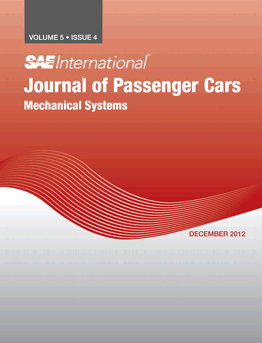
SAE International Journal of Passenger Cars-Mechanical Systems
Advancing Knowledge for Safer, Smarter VehiclesSAE International Journal of Passenger Cars-Mechanical Systems, published by SAE International, serves as a vital platform for researchers, engineers, and industry professionals focused on the dynamics of passenger vehicle mechanical systems. With an ISSN of 1946-3995 and E-ISSN of 1946-4002, this journal bridges academic research with practical applications in the automotive field. Although coverage in Scopus was discontinued after 2021, the journal has still contributed significantly to the realms of automotive engineering, safety, and mechanical engineering, evidenced by its Scopus rankings and percentiles across various categories, including a rank of #57 in Automotive Engineering. This multidisciplinary journal is key for those looking to advance their knowledge and explore innovative solutions in automotive mechanics, with an emphasis on enhancing vehicle performance, reliability, and safety. While current open access options are detailed further on their website, the journal continues to maintain a commitment to disseminating valuable insights that can shape future automotive technologies and practices.

Ocean Systems Engineering-An International Journal
Showcasing Cutting-edge Advances in Marine and Mechanical EngineeringOcean Systems Engineering - An International Journal, published by TECHNO-PRESS, is a pivotal platform for the dissemination of cutting-edge research in the fields of Automotive Engineering, Mechanical Engineering, Ocean Engineering, and Water Science and Technology. With its ISSN 2093-6702 and E-ISSN 2093-677X, the journal serves as a key resource for scholars and practitioners alike, offering insights into innovative solutions and advancements within these disciplines. Operating under a Q3 ranking in several categories including Automotive and Ocean Engineering, the journal showcases research that significantly contributes to both theoretical and practical aspects of engineering and environmental science. Although it does not currently offer an open-access model, the journal maintains an active presence in the academic community, supported by a dedicated readership keen on exploring the latest developments from 2017 to 2024. Situated in South Korea, it is uniquely positioned to bridge international research efforts and enhance collaborative studies aimed at addressing critical ocean-related challenges.
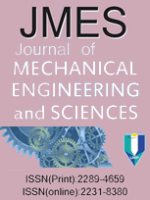
Journal of Mechanical Engineering and Sciences
Elevating Research in Mechanical Engineering and BeyondThe Journal of Mechanical Engineering and Sciences (ISSN: 2289-4659, E-ISSN: 2231-8380), published by UNIV MALAYSIA PAHANG, is a prominent open access journal established in 2011, dedicated to advancing the field of mechanical engineering and associated sciences. Covering a wide array of topics from industrial manufacturing processes to computational mechanics, the journal serves as a vital platform for researchers, professionals, and students to disseminate innovative findings and methodologies. With impressive Scopus rankings, including a place in the 60th percentile for Industrial and Manufacturing Engineering, the journal holds a significant position among its peers, facilitating global academic discourse. Located in Kuantan, Pahang, Malaysia, the journal emphasizes accessibility and collaboration within the engineering community, encouraging submissions that contribute to both theoretical and applied aspects of mechanical engineering.

Journal of Aeronautics Astronautics and Aviation
Elevating Research in Aerospace Engineering and Space SciencesJournal of Aeronautics Astronautics and Aviation, published by the Aeronautical & Astronautical Society Republic of China, is a premier scholarly journal dedicated to advancing knowledge in the dynamic fields of aerospace engineering and space sciences. Operating under the ISSN 1990-7710, this journal plays a pivotal role in disseminating innovative research and practice-oriented studies that address both theoretical and applicative aspects of aeronautics and astronautics. With an impressive history spanning from 2006 to 2024, the journal has established itself as a valuable resource for researchers, professionals, and students alike, featuring contributions that reflect the latest developments and trends within the industry. In the latest rankings, it holds a Q3 classification in Aerospace Engineering and Q4 in Space and Planetary Science, indicating its growing influence despite its niche scope. With an open access model that facilitates widespread readership, the Journal of Aeronautics Astronautics and Aviation strives to foster collaboration and knowledge sharing in these ever-evolving scientific domains.

JOURNAL OF FLUID MECHANICS
Pioneering research in the realm of fluid mechanics.JOURNAL OF FLUID MECHANICS, published by Cambridge University Press, is a premier international journal recognized for its significant contributions to the field of fluid dynamics. With an esteemed impact factor that places it in the Q1 category across multiple disciplines, including Applied Mathematics, Condensed Matter Physics, Mechanical Engineering, and Mechanics of Materials, this journal serves as a vital resource for researchers and practitioners alike. Established in 1956, it provides a platform for innovative and high-quality research articles that advance the understanding of fluid mechanics phenomena. The journal's rankings underscore its prestige, with Scopus recognizing it among the top journals in its category. Although it currently does not offer open access, the journal remains accessible to educational institutions and professionals in the United Kingdom and beyond. By addressing critical and emerging topics in fluid mechanics, JOURNAL OF FLUID MECHANICS is essential for those striving to push the boundaries of knowledge and application in this dynamic field.